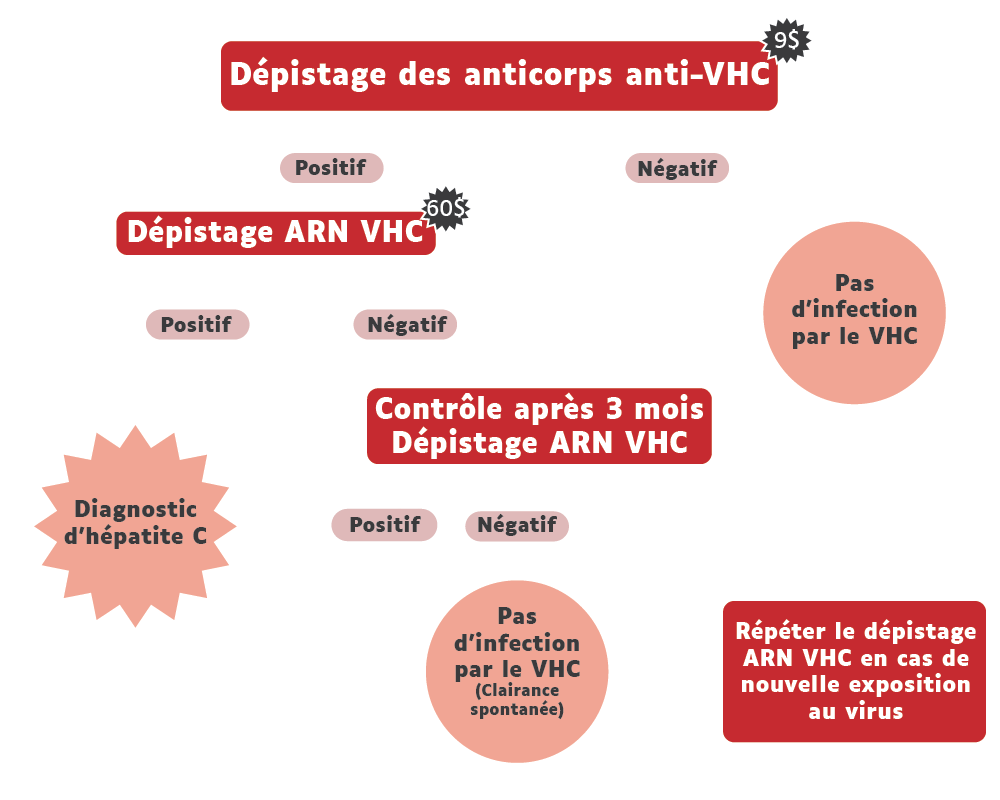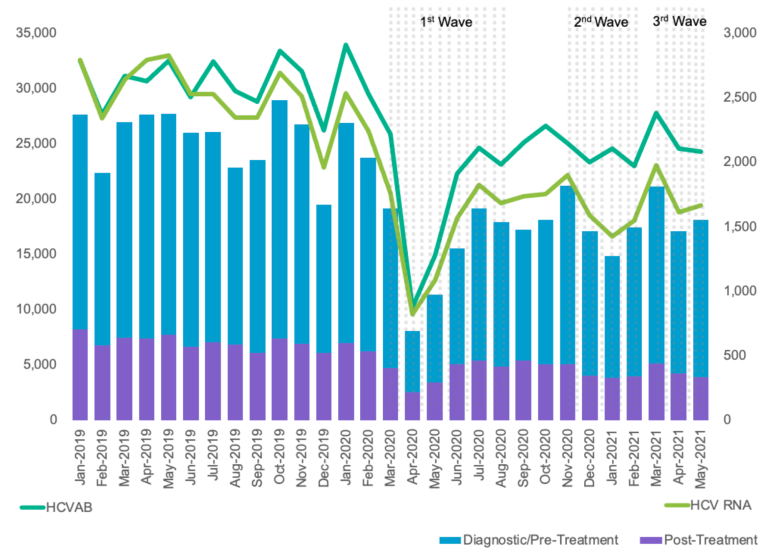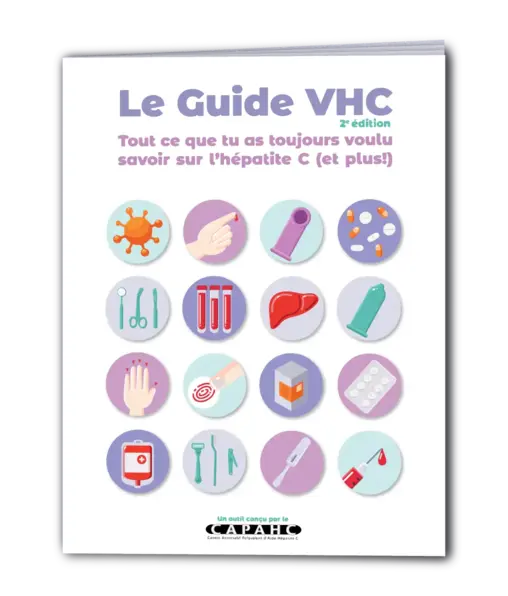Your reference for hepatitis C in Quebec
Testing and diagnosis
In the United States, HCV screening recommendations were based on risk factors up until 2012. As of 2012, a recommendation was introduced signaling that all patients born between 1945 and 1975 should be screened once in their life, independent of risk factors.
In 2020, the Center for Disease Control (CDC) updated its HCV screening recommendations in order to include all people at least once per lifetime and also all pregnant people once per pregnancy.1 These decisions followed recent U.S. data including an increase in the number of new hepatitis C cases, particularly among young people.
In Canada, the recommendations of the Canadian Task Force on Preventive Health Care are based solely on risk factors. They do not include screening for people born between 1945 and 1975, contrary to the requests of the Canadian Association for Study of the Liver (CASL) and the Canadian Hepatitis C Network (CanHepC) who plead for.
In 2021, British Columbia put out provincial recommendations to test all people born between 1945 and 1975 once in their life.
In Quebec, hepatitis C screening is only recommended for people with risk factors for HCV:
- Having consumed drugs by injection, even if only once;
- Originating from a country or region where HCV is endemic (Pakistan, Egypt, Syria, Romania, Taiwan, Eastern Europe, Central Asia, Central sub Saharan Africa). Note that HCV screening is not required by Immigration Canada;
- Being a GBMSM living with HIV or who plans on going on PrEP;
- Being a person living with HIV and having contracted lymphogranuloma venereum (LGV) or having possibly contracted the hepatitis B virus through contact with blood;
- Having been exposed to blood or other potentially infected biological fluids (tattooing or piercing in non-sterile environments, or by exposure within a work context or a non-professional context);
- Having undergone a procedure (surgical or otherwise) with potentially contaminated material or instruments in a region of the world where the HCV prevalence is high (> 2 %);
- Having received a transfusion of blood or blood products, or a transplant of cell or organ tissue (in Canada, prior to April 1992);
- Being a pregnant person who is associated with HCV risk factors prior to or during the pregnancy;
- Having had experience of incarceration;
- Receiving services in a center for drug addiction;
- Undergoing hemodialysis;
- Infants and children born to a parent who is a carrier of HCV (RNA or HCV positive). Only concerning pregnant people.
In addition to this list, government recommendations add the following clinical conditions:
- Presenting an unexplained increase of the aspartate aminotransferase (AST) or alanine transaminase (ALT) enzymes or both transaminases;
- Having a hepatic disease that may be detected by clinical, biological and/or radiological indicators;
- Presenting extra-hepatic manifestation (EHM) resembling HCV.
In theory, all people who request screening, even in the absence of risk factors, should have access to it, but the application of this recommendation is not uniformly distributed. We also know that declaring risk factors is suboptimal because there are numerous obstacles to uncovering them, notably discrimination and the stigma associated with such risk factors. The practice of screening pregnant people is not yet recommended in Quebec, though we are currently awaiting the next set of recommendations from the Society of Obstetricians and Gynaecologists of Canada (SOGC). For the time being, the practice is becoming more and more commonplace.
Screening for chronic hepatitis C is done most often involving a blood test and completed in two steps:
- First, a screening is done for HCV antibodies in order to determine if a person has been exposed to HCV;
- Next, an RNA HCV test is conducted in order to determine whether the person is a carrier of an active (or viremic) hepatitis C virus.
After exposure to HCV, a person develops antibodies within 6 to 8 weeks. The window for HCV testing is 12 weeks. It is important to note that this period may be extended in the case of HIV-HBV co-infection.
Following exposure to HCV, a person develops antibodies within six to eight weeks. The window period for HCV screening is 12 weeks. It is important to note that this duration can be lengthened in cases of HIV-HBV coinfection. HCV antibodies are present in all people who come into contact with the virus, but contrary to HBV antibodies, they don’t protect against later infection. A person with no history of anti-HCV serology will be prescribed an HCV antibody test. This test is always done first because its cost is much less than the RNA test ($9 vs. $60).
- If the test is negative, the screening is over and the person was not exposed to HCV.
- If the antibody test is positive, the person was exposed to HCV. The next step will be to determine whether they are part of the 15-40% of people who go through spontaneous HCV clearance or whether they are a carrier of the virus.
After a positive HCV antibody test, one must undergo an HCV RNA testing, which will provide an indication of their viral load (the measure of virus per mL of blood). This test indicates both the qualitative RNA and the quantitative viral load. HCV RNA is present in the body after exposure to the virus.
- If the test comes back positive, the person is viremic and a carrier of chronic hepatitis C.
- If the test is negative, this suggests the person underwent a spontaneous HCV clearance. An observation period of three months, however, is recommended to confirm the results.
If the person has already received a positive HCV antibody test (for example, for someone whose hepatitis C infection was treated and cured), it is recommended to proceed directly to HCV RNA testing. If exposure to HCV is confirmed (after using, for example, a syringe shared with someone who is HCV positive), is it possible to conduct HCV RNA testing after four weeks.
Hepatitis C is one of the nationally notifiable diseases (NND), which means the treating physician must notify local public health authorities of each new case.

Genotyping is no longer necessary prior to beginning treatment thanks to pangenotypic treatments. It is possible, however, that health professionals request genotyping (if only to delay the beginning of treatment) for people who are at greater risk of contracting HCV in order to differentiate a failure of treatment from future reinfection.
HCV screening is frequently conducted via blood test. Other methods and technologies do, however, exist.
Rapid tests
Rapid tests expedite the process of antibody screening using a simple capillary puncture or saliva sample. Depending on the type of test used, results can be ready in one minute (INSTI® HCV Test) or up to 20-40 minutes (OraQuick® HCV Rapid Antibody Test). For the time being, only OraQuick® is licensed in Canada and is only conducted via capillary puncture.
The test’s sensitivity is at 95.9% and its specificity is at 99%.6 According to a recent study, the wait time for results can even be reduced to five minutes without loss of quality for identifying viremic patients.
These rapid tests are used in particular to offer screening at points of service: in community organizations, pharmacies, on the street, etc. They provide easier access: no need to make an appointment, reduced waiting time for results and therefore less stress, the possibility of offering better screening conditions in a familiar, non-medical environment, etc.

These tests do not, however, provide a hepatitis C diagnosis. If a rapid test comes back positive, the person concerned is directed to the appropriate services in order to get HCV RNA testing.
In Quebec, according to the Act respecting health services and social services, screening is a medical act only practicable by doctors, nurses and midwives. In other countries, such as the United Kingdom, Australia or France, these rapid tests can be administered by community workers or trained peers. Considering the context of current nursing shortages and difficulty in accessing screening (worsened by the COVID-19 pandemic), it would be highly beneficial to make this medical act practicable by other professions. Community workers working to combat HIV and other STBBIs are in an advantageous position for reaching key communities and are indispensable partners in meeting hepatitis C elimination targets. Additionally, the decentralization of health care is an essential strategy recommended by the WHO in combating viral hepatitis.
This is why the Provincial Committee about Hepatitis C, coordinated by CAPAHC, is committed to advocacy work for rapid tests..
Despite rapid tests for HIV becoming available in Canada in November, 2020, this is still not the case for HCV. To move forward, the manufacturers would need to make a request to Health Canada for licensing their rapid testing technology.
REFLEX tests
The Reflex testing process allows for HCV RNA testing (following a positive antibody test) to be conducted using a single vial of blood, which can be part of the same blood sample used for the antibody test. Reflex testing can also be done using dried blood (see below). This technology reduces the number of steps for a diagnosis by reducing the number of required consultations and blood samples. This method is already implemented in eight provinces including Alberta, British Columbia and New Brunswick, but not Quebec.
Dried blood spot (DBS) test
The dried blood spot test (DBS) involves using a filter paper to collect drops of blood from a capillary puncture in order to analyze them at a later time. This allows for screening to be conducted in areas where material is less available. Filter papers can also be sent by mail for testing in laboratories capable of both HCV antibody testing and HCV RNA testing. HCV DBS antibody testing has a sensitivity rate of 98% and specificity rate of 99%.10 HCV DBS RNA testing has a sensitivity rate of 98% and specificity rate of 98%.
GeneXpert®
GeneXpert® can perform PCR testing in 60-100 minutes and screen for various viruses including SARS-CoV2, HPV, HIV, and HCV. Currently, Health Canada has not yet licensed the device for HCV testing, but Action Hepatitis Canada has requested the manufacturer, CepHEID, to prioritize licensing its technology for HCV testing.
It is important to underline that the COVID-19 pandemic impacted access to screening. A recent study in Ontario demonstrated that HCV testing has still not returned to its pre-pandemic levels.

Impact of the COVID-19 pandemic on hepatitis C screening
in Ontario, Canada





